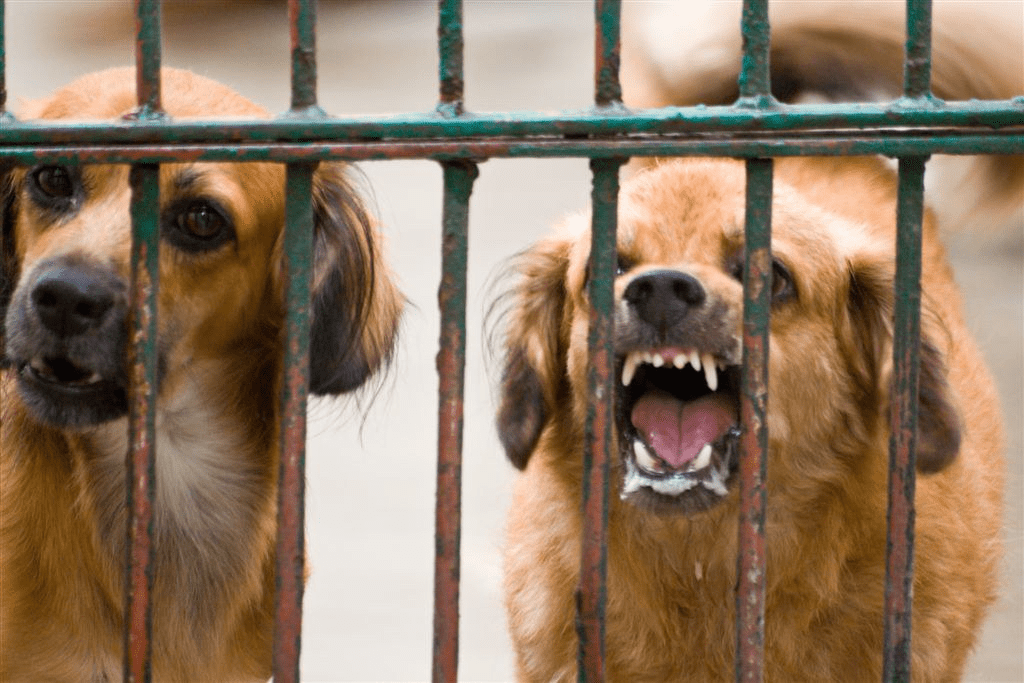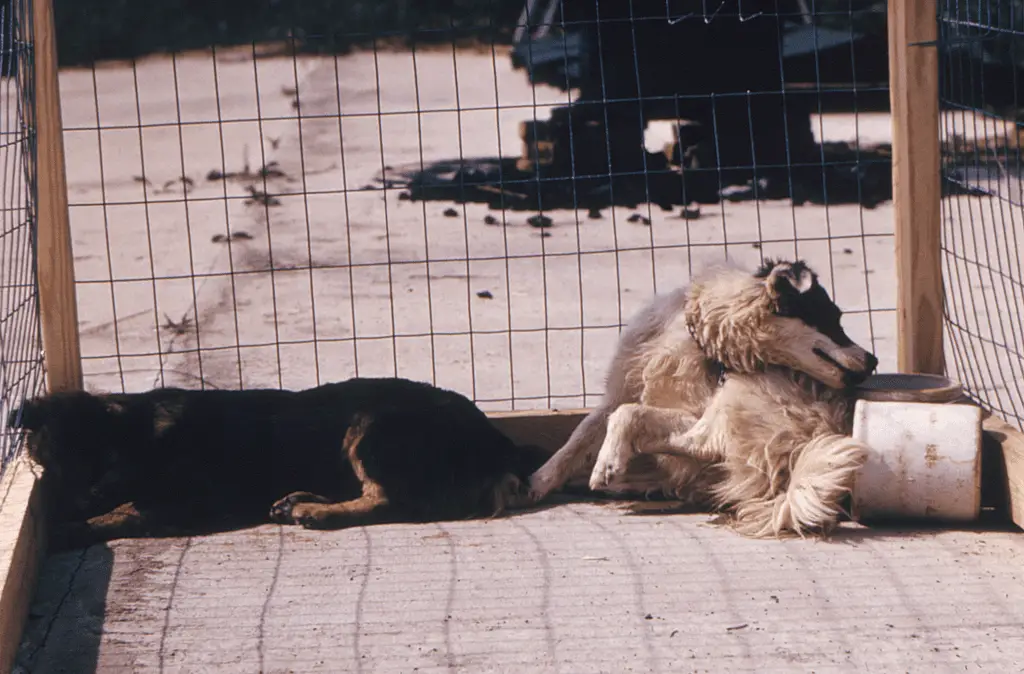Rabies is a severe, and often fatal, viral polioencephalitis that specifically affects the gray matter of a dog’s brain and its central nervous system.
The primary way the rabies virus is transmitted to dogs in most parts of the world is through a bite from a disease carrier: foxes, raccoons, skunks, and bats.
Infected saliva entering an open wound, the mouth, or the eyes can also potentially lead to infection.
Understanding how dogs get rabies can help in both prevention and early treatment.
- What Is Rabies in Dogs?
- How Do Dogs Get Rabies?
- How Long Is The Incubation Period For Rabies In Dogs?
- What Are the Symptoms of Rabies In Dogs?
- How Common Is Rabies In Dogs
- Is There a Cure For Rabies In Dogs?
- When Should My Dog Be Vaccinated For Rabies?
- How Long Is The Rabies Vaccine Good For Dogs?
- Do Most Dogs Carry Rabies?
- Is Rabies In Dogs Contagious For Humans or Other Pets?
- What Is The Cost of Treating Rabies in Dogs?
- How Can You Prevent Rabies In Dogs?
- FAQs
- Q: What are the signs of rabies in dogs?
- Q: Can a dog have rabies even if they have been vaccinated?
- Q: How do veterinarians diagnose rabies in dogs?
- Q: Are there rabies shots available for dogs?
- Q: What are the clinical signs of rabies in dogs?
- Q: What should I do if my dog has been bitten by a rabid animal?
- Q: Can dogs transmit rabies to humans?
- Q: How many rabies cases are there in dogs in the United States?
- Q: What are the first signs of rabies in a dog?
- In Conclusion
Key Takeaway
- Rabies is a viral disease that affects the nervous system of dogs, causing aggressive behavior, paralysis, and ultimately, death.
- Dogs can get rabies through bites or contact with the saliva of an infected animal, such as bats, raccoons, skunks, and other rabid animals.
- The incubation period for rabies in dogs can range from 1 week to 1 year, but typically it is around 2-8 weeks after exposure to the virus.
What Is Rabies in Dogs?

Rabies is a viral disease that significantly affects mammals, including dogs.
It’s caused by a virus that is secreted in the saliva and primarily infects the nervous system, including the brain and spinal cord.
Once symptoms appear, it’s invariably fatal.
Rabies is transmitted mainly through bites from an infected animal. The virus can be passed when the infected animal’s saliva enters another animal’s body, typically through a bite wound.
Non-bite exposures (such as getting the saliva or brain/spinal tissue of an infected animal – dead or alive – in the eyes, nose, mouth, or an open cut) are less common but possible.
How Do Dogs Get Rabies?

Dogs primarily contract rabies through bites from infected animals but can also get rabies when saliva from infected animals comes in contact with open cuts or wounds.
The rabies virus is secreted in the saliva of infected animals. When a rabid animal bites another animal or a human, it can transmit the virus.
The virus then travels from the wound through the nerves, eventually reaching the brain and spinal cord where it causes inflammation and severe damage.
Apart from bites, dogs can also get rabies through non-bite exposure, which is less common but possible.
This happens when the saliva from an infected animal comes into contact with open cuts or wounds, or mucous membranes like the eyes or mouth.
How Long Is The Incubation Period For Rabies In Dogs?
The incubation period for rabies in dogs ranges from 2 weeks to several months or even up to a year in rare cases.
Factors that influence the incubation period include the amount of virus introduced and the location of the bite.
Most commonly, the average incubation period in dogs is between 2 to 8 weeks.
However, it’s important to note that even if a dog doesn’t show symptoms, it can still transmit the virus during the later stages of the incubation period.
What Are the Symptoms of Rabies In Dogs?
- Change in tone of bark
- Unusual aggression
- Inability to eat or drink
- Fever
- Seizures
- Paralysis
- Hydrophobia (fear of water)
- Jaw is dropped
- Inability to swallow
- Change in behavior such as restlessness or apprehension
- Excessive drooling or foaming at the mouth
- Sensitivity to light, sound, and touch
- Loss of appetite
- Weakness or unsteadiness
- Disorientation or confusion
- Sudden death
How Common Is Rabies In Dogs
According to the United States Centers for Disease Control and Prevention (CDC), only 1 to 3 cases of rabies in domestic animals are reported annually nationwide.
According to the World Health Organization, domestic dogs are responsible for up to 99% of human rabies transmissions.
It’s important to note that even in regions where dog rabies is well-controlled, dogs can still be at risk from wildlife like bats, raccoons, and foxes that can carry the disease.
Is There a Cure For Rabies In Dogs?
Unfortunately, once a dog shows clinical signs of rabies, the disease is nearly always fatal. There is no cure or treatment for rabies that can reverse the progression of the disease once symptoms appear.
The primary method to deal with rabies in dogs is prevention through vaccination.
If a dog is suspected to have been exposed to the rabies virus (through a bite from a wild animal, for example), it’s crucial to seek veterinary care immediately.
A booster of the rabies vaccine may be given to help fight off the virus before it can establish an infection.
When Should My Dog Be Vaccinated For Rabies?
Dogs should be vaccinated for rabies as soon as possible and no later than four months of age.
Puppies should receive a booster shot one year after their initial vaccination, and then every three years thereafter.
It is important to maintain your dog’s rabies vaccination status on a regular basis to provide the best protection for both you and your pet.
In some jurisdictions, such as certain parts of Canada, it may be required by law that all dogs be vaccinated against rabies at certain intervals.
If in doubt about laws in your area, contact your local animal shelter or veterinarian for clarification.
How Long Is The Rabies Vaccine Good For Dogs?
Rabies vaccines are labeled as being effective for either one year or three years. However, some states require annual vaccination regardless of the vaccine’s label.
After the initial vaccination and the first booster shot given a year later, most dogs are typically vaccinated every three years.
It’s important to note that this can depend on local laws and regulations, as some areas may require more frequent rabies vaccinations.
Recent research has suggested that the immunity provided by the rabies vaccine may last longer than previously thought, potentially up to five years. However, these findings have not yet changed general vaccination guidelines.
Do Most Dogs Carry Rabies?
Contrary to popular belief, most dogs do not carry rabies. While dogs can become infected with the rabies virus if they are bitten by another animal that has the disease, not all dogs have rabies.
Rabies in dogs is preventable through regular vaccinations.
Is Rabies In Dogs Contagious For Humans or Other Pets?
Yes, rabies in dogs is contagious to both humans and other pets. Rabies is a zoonotic disease, which means it can be transmitted from animals to humans.
The transmission usually occurs when an infected animal bites another animal or a human, introducing the virus through saliva into the body.
What Is The Cost of Treating Rabies in Dogs?
According to various sources, the cost of a rabies vaccine can range from $15 to $25 on average, although this can vary depending on the region and type of veterinary clinic.
Some clinics and animal service providers offer lower-cost vaccination clinics that might reduce this cost.
How Can You Prevent Rabies In Dogs?
- Vaccination: This is the most effective way to prevent rabies. Dogs should be vaccinated at around 12 to 16 weeks of age, with a booster shot given one year later. Then, every three years thereafter (or as required by local laws).
- Avoid Contact with Wildlife: Limit your dog’s exposure to wild animals, which can be carriers of the rabies virus. Keep your dog on a leash during walks and monitor outdoor playtime.
- Secure Your Property: Make your property less attractive to wildlife by sealing garbage cans, eliminating food sources, and covering any potential entry points into your home or yard.
- Report Strays and Sick Animals: If you spot a stray dog or a wild animal acting strangely, report it to local animal control authorities. They can handle the situation appropriately and safely.
- Teach Your Dog Not to Approach Unknown Animals: Training your dog not to approach or interact with unknown animals can help reduce the risk of contact with a rabid animal.
- Regular Vet Check-ups: Regular veterinary check-ups can ensure your dog’s vaccinations are up-to-date and can help detect any potential health issues early.
FAQs
Q: What are the signs of rabies in dogs?
A: The signs of rabies in dogs include behavior changes, excessive drooling, aggression, paralysis, and difficulty swallowing.
Q: Can a dog have rabies even if they have been vaccinated?
A: While most vaccinated dogs are protected against rabies, there is a small possibility that a vaccinated dog may still contract the virus if bitten by a rabid animal.
Q: How do veterinarians diagnose rabies in dogs?
A: Veterinarians diagnose rabies in dogs by examining their symptoms, conducting laboratory tests on their saliva or brain tissue, and consulting their vaccination records.
Q: Are there rabies shots available for dogs?
A: Yes, there are rabies shots available for dogs. It is recommended to vaccinate dogs against rabies to protect them from the virus.
Q: What are the clinical signs of rabies in dogs?
A: The clinical signs of rabies in dogs typically include behavioral changes, aggression, excessive salivation, paralysis, and difficulty swallowing.
Q: What should I do if my dog has been bitten by a rabid animal?
A: If your dog has been bitten by a rabid animal, you should immediately seek veterinary assistance. Your dog may need to be quarantined and tested for rabies.
Q: Can dogs transmit rabies to humans?
A: Yes, dogs can transmit rabies to humans through a bite or by their infected saliva entering an open wound.
Q: How many rabies cases are there in dogs in the United States?
A: The number of rabies cases in dogs in the United States varies each year. But, it is generally low due to widespread vaccination programs.
Q: What are the first signs of rabies in a dog?
A: The first signs of rabies in a dog may include changes in behavior. This includes increased aggression or restlessness, excessive drooling, and difficulty swallowing.
In Conclusion
In summary, rabies is a dangerous, often fatal disease that impacts dogs and other mammals.
It’s primarily transmitted through bites from infected animals, although it can also spread if infected saliva contacts an open wound or mucous membranes.
Despite its severity, rabies can be effectively prevented through regular vaccinations and by avoiding contact with wild animals.
Early detection and prevention are key to ensuring the health and safety of our canine companions.





Leave a Reply